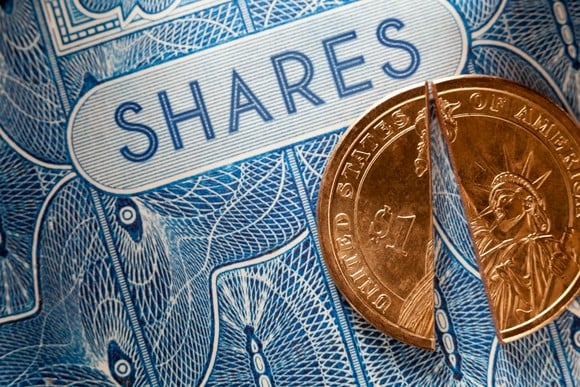In case you haven't noticed, the bulls have been running wild on Wall Street for two years. As of the closing bell on Dec. 30, the ageless Dow Jones Industrial Average, broad-based S&P 500, and growth-centric Nasdaq Composite had respectively rallied by 13%, 24%, and 30% for 2024.
Although the artificial intelligence (AI) revolution is widely credited with the stock markets outsized returns, it's important not to overlook the role stock-split euphoria has played in lifting the tide for some of Wall Street's most-influential businesses.

Image source: Getty Images.
A stock split is a tool that allows publicly traded companies to cosmetically alter their share price and outstanding share count by the same magnitude. Splits are "cosmetic" in the sense that they have no effect on market cap and in no way impact a company's operating performance.
In 2024, more than a dozen high-profile companies undertook stock splits, and all but one was of the forward variety. A "forward" split is designed to reduce a company's share price to make it more nominally affordable for everyday investors who aren't able to buy fractional shares through their broker.
Among these top stock-split stocks are two no-brainer buys for 2025, as well as one highflier that would be best avoided.
Stock-split stock No. 1 to buy hand over fist in 2025: Sirius XM Holdings
The first stock-split stock that can be purchased with confidence in the new year is arguably the most unique of all splits from 2024: satellite-radio operator Sirius XM Holdings (SIRI 0.23%).
Sirius is the lone prominent business to have completed a reverse split (1-for-10) last year. While most companies conduct reverse splits from positions of operating weakness and are attempting to avoid delisting from a major stock exchange, this wasn't the case with Sirius XM. Following its merger with Liberty Media's Sirius XM tracking stock, Sirius XM split its shares to get back on the radar of institutional investors. Some investment funds won't buy stocks with a share price below $5, and Sirius XM's reverse split resolved this concern.

NASDAQ: SIRI
Key Data Points
One of the biggest competitive advantages for Sirius XM, relative to other radio operators, is its revenue generation. For terrestrial and online radio companies, advertising revenue is king. While lengthy periods of economic expansion favor ad-driven operating models, things can get dicey for ad-reliant radio companies during recessions.
Through the first nine months of 2024, Sirius XM had generated only around 20% of its net sales from advertising (via Pandora). In comparison, almost 77% of net revenue can be traced to highly predictable subscriptions. When economic turbulence arises, Sirius XM's subscribers are far less likely to cancel their service than businesses are to pare back their marketing budgets.
To add, Sirius XM is a legally operating monopoly. Though it's still fighting for listeners with traditional radio providers, it's the only licensed satellite-radio operator. Having this distinction affords the company strong subscription pricing power more often than not.
Sirius XM's valuation is also attractive in a historically pricey stock market. The company's forward price-to-earnings (P/E) ratio of 7.5 is nearly an all-time low, and its dividend yield is creeping closer to 5%. It has all the hallmarks patient value investors are looking for.

Image source: Getty Images.
Stock-split stock No. 2 to buy hand over fist in 2025: Sony Group
The second stock-split stock that investors would be wise to scoop up in 2025 in Japan-based electronics colossus Sony Group (SONY 0.58%). Sony's American depositary receipts (ADRs) completed a 5-for-1 forward split in October, which reduced the company's share price from the $90 range to, at the time, less than $20.
The biggest battle Sony is waging right now is investor apathy. We're effectively in the middle of the current gaming console cycle, with the next-generation PlayStation 6 likely to arrive at some point in 2027, based on various estimates. New console releases have historically provided a boost to Sony's sales and profits.
However, Sony Group is still finding new ways to capitalize on its existing PlayStation 5 console. Last year, it increased the price of its console in Japan by 19%. It's also emphasizing PlayStation Plus, which is a high-margin, multitiered subscription service that allows gamers to play with their friends, access exclusive titles, and save their data in the cloud.

NYSE: SONY
Key Data Points
But there's more to Sony Group than just gaming. For instance, it's a leading supplier of image sensors, which are used in everything from next-generation smartphones to industrial/security cameras. The company's Imaging and Sensing Solutions segment delivered year-over-year sales growth of 32% in the fiscal second quarter, with operating income effectively doubling to $92.4 million.
Long-term investors should also appreciate Sony Group's capital-return program. In May, when the company initially unveiled its forward split, management laid out plans to return up to $1.6 billion via share buybacks over the next year, as well as increase the dividend to a total payout ratio of 40% for the fiscal year ending in March 2027.
Lastly, the valuation makes sense. Sony Group's forward P/E ratio of 17 remains attractive amid a pricey stock market.
The stock-split stock you'd be smart to avoid in 2025: MicroStrategy
However, not all stock-split stocks are worth buying in 2025. Although companies conducting splits have historically outperformed the S&P 500 in the 12-month period following their split announcement, the red flags are mounting for "Bitcoin (BTC +1.67%) Treasury Company" MicroStrategy (MSTR +3.38%). MicroStrategy completed a 10-for-1 forward split in August.
The excitement surrounding MicroStrategy has to do with CEO Michael Saylor's ongoing acquisition of the world's largest digital currency by market value. As of Dec. 23, Saylor's company held 444,262 Bitcoin, which is more than 2% of the 21 million token supply that'll ever be mined. By issuing its own shares and convertible debt to purchase Bitcoin, MicroStrategy is being viewed as a leveraged way to play the world's hottest cryptocurrency.

NASDAQ: MSTR
Key Data Points
But this strategy isn't anywhere as close to foolproof as MicroStrategy's rapidly rising share price would suggest.
For instance, history teaches us that leverage-driven investments rarely succeed. MicroStrategy continuing to sell its common stock to buy Bitcoin won't be enough to artificially support a higher price for the world's top cryptocurrency.
What's more, MicroStrategy's AI-inspired enterprise analytics software segment isn't generating enough operating cash flow (at the moment) to service the interest payments on its outstanding debt. This inability to service its debt, coupled with steep bear market declines being commonplace for Bitcoin throughout its history, makes Saylor's strategy particularly risky.
The other issue is that MicroStrategy is being valued at an inexplicable premium to its Bitcoin assets. With Bitcoin valued at $92,590 per token, as of this writing, MicroStrategy's Bitcoin assets are worth $41.1 billion. Yet as of the closing bell on Dec. 30, MicroStrategy had a market cap of $74.2 billion. Excluding its software operations, investors are assigning around a 78% premium to its Bitcoin assets, which simply isn't sustainable.